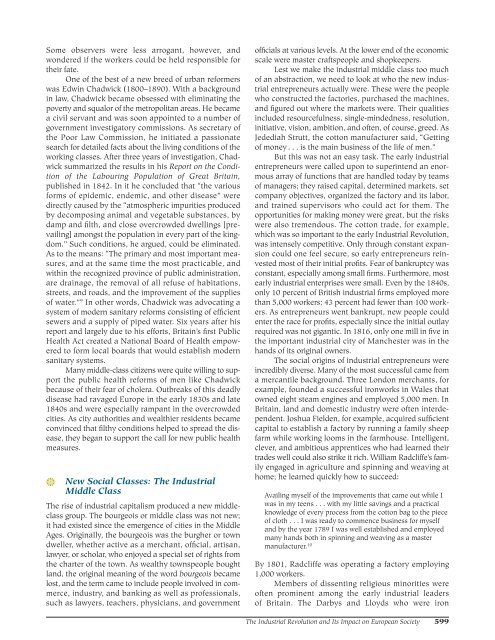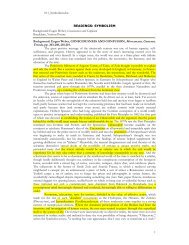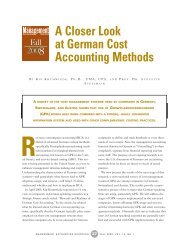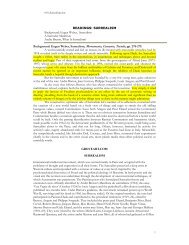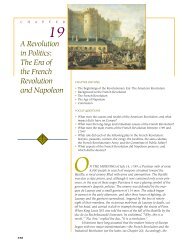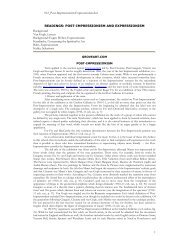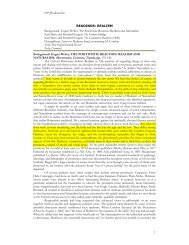20 The Industrial Revolution and Its Impact on European Society
20 The Industrial Revolution and Its Impact on European Society
20 The Industrial Revolution and Its Impact on European Society
Create successful ePaper yourself
Turn your PDF publications into a flip-book with our unique Google optimized e-Paper software.
Some observers were less arrogant, however, <str<strong>on</strong>g>and</str<strong>on</strong>g><br />
w<strong>on</strong>dered if the workers could be held resp<strong>on</strong>sible for<br />
their fate.<br />
One of the best of a new breed of urban reformers<br />
was Edwin Chadwick (1800–1890). With a background<br />
in law, Chadwick became obsessed with eliminating the<br />
poverty <str<strong>on</strong>g>and</str<strong>on</strong>g> squalor of the metropolitan areas. He became<br />
a civil servant <str<strong>on</strong>g>and</str<strong>on</strong>g> was so<strong>on</strong> appointed to a number of<br />
government investigatory commissi<strong>on</strong>s. As secretary of<br />
the Poor Law Commissi<strong>on</strong>, he initiated a passi<strong>on</strong>ate<br />
search for detailed facts about the living c<strong>on</strong>diti<strong>on</strong>s of the<br />
working classes. After three years of investigati<strong>on</strong>, Chadwick<br />
summarized the results in his Report <strong>on</strong> the C<strong>on</strong>diti<strong>on</strong><br />
of the Labouring Populati<strong>on</strong> of Great Britain,<br />
published in 1842. In it he c<strong>on</strong>cluded that “the various<br />
forms of epidemic, endemic, <str<strong>on</strong>g>and</str<strong>on</strong>g> other disease” were<br />
directly caused by the “atmospheric impurities produced<br />
by decomposing animal <str<strong>on</strong>g>and</str<strong>on</strong>g> vegetable substances, by<br />
damp <str<strong>on</strong>g>and</str<strong>on</strong>g> filth, <str<strong>on</strong>g>and</str<strong>on</strong>g> close overcrowded dwellings [prevailing]<br />
am<strong>on</strong>gst the populati<strong>on</strong> in every part of the kingdom.”<br />
Such c<strong>on</strong>diti<strong>on</strong>s, he argued, could be eliminated.<br />
As to the means: “<str<strong>on</strong>g>The</str<strong>on</strong>g> primary <str<strong>on</strong>g>and</str<strong>on</strong>g> most important measures,<br />
<str<strong>on</strong>g>and</str<strong>on</strong>g> at the same time the most practicable, <str<strong>on</strong>g>and</str<strong>on</strong>g><br />
within the recognized province of public administrati<strong>on</strong>,<br />
are drainage, the removal of all refuse of habitati<strong>on</strong>s,<br />
streets, <str<strong>on</strong>g>and</str<strong>on</strong>g> roads, <str<strong>on</strong>g>and</str<strong>on</strong>g> the improvement of the supplies<br />
of water.” 9 In other words, Chadwick was advocating a<br />
system of modern sanitary reforms c<strong>on</strong>sisting of efficient<br />
sewers <str<strong>on</strong>g>and</str<strong>on</strong>g> a supply of piped water. Six years after his<br />
report <str<strong>on</strong>g>and</str<strong>on</strong>g> largely due to his efforts, Britain’s first Public<br />
Health Act created a Nati<strong>on</strong>al Board of Health empowered<br />
to form local boards that would establish modern<br />
sanitary systems.<br />
Many middle-class citizens were quite willing to support<br />
the public health reforms of men like Chadwick<br />
because of their fear of cholera. Outbreaks of this deadly<br />
disease had ravaged Europe in the early 1830s <str<strong>on</strong>g>and</str<strong>on</strong>g> late<br />
1840s <str<strong>on</strong>g>and</str<strong>on</strong>g> were especially rampant in the overcrowded<br />
cities. As city authorities <str<strong>on</strong>g>and</str<strong>on</strong>g> wealthier residents became<br />
c<strong>on</strong>vinced that filthy c<strong>on</strong>diti<strong>on</strong>s helped to spread the disease,<br />
they began to support the call for new public health<br />
measures.<br />
<br />
New Social Classes: <str<strong>on</strong>g>The</str<strong>on</strong>g> <str<strong>on</strong>g>Industrial</str<strong>on</strong>g><br />
Middle Class<br />
<str<strong>on</strong>g>The</str<strong>on</strong>g> rise of industrial capitalism produced a new middleclass<br />
group. <str<strong>on</strong>g>The</str<strong>on</strong>g> bourgeois or middle class was not new;<br />
it had existed since the emergence of cities in the Middle<br />
Ages. Originally, the bourgeois was the burgher or town<br />
dweller, whether active as a merchant, official, artisan,<br />
lawyer, or scholar, who enjoyed a special set of rights from<br />
the charter of the town. As wealthy townspeople bought<br />
l<str<strong>on</strong>g>and</str<strong>on</strong>g>, the original meaning of the word bourgeois became<br />
lost, <str<strong>on</strong>g>and</str<strong>on</strong>g> the term came to include people involved in commerce,<br />
industry, <str<strong>on</strong>g>and</str<strong>on</strong>g> banking as well as professi<strong>on</strong>als,<br />
such as lawyers, teachers, physicians, <str<strong>on</strong>g>and</str<strong>on</strong>g> government<br />
officials at various levels. At the lower end of the ec<strong>on</strong>omic<br />
scale were master craftspeople <str<strong>on</strong>g>and</str<strong>on</strong>g> shopkeepers.<br />
Lest we make the industrial middle class too much<br />
of an abstracti<strong>on</strong>, we need to look at who the new industrial<br />
entrepreneurs actually were. <str<strong>on</strong>g>The</str<strong>on</strong>g>se were the people<br />
who c<strong>on</strong>structed the factories, purchased the machines,<br />
<str<strong>on</strong>g>and</str<strong>on</strong>g> figured out where the markets were. <str<strong>on</strong>g>The</str<strong>on</strong>g>ir qualities<br />
included resourcefulness, single-mindedness, resoluti<strong>on</strong>,<br />
initiative, visi<strong>on</strong>, ambiti<strong>on</strong>, <str<strong>on</strong>g>and</str<strong>on</strong>g> often, of course, greed. As<br />
Jedediah Strutt, the cott<strong>on</strong> manufacturer said, “Getting<br />
of m<strong>on</strong>ey . . . is the main business of the life of men.”<br />
But this was not an easy task. <str<strong>on</strong>g>The</str<strong>on</strong>g> early industrial<br />
entrepreneurs were called up<strong>on</strong> to superintend an enormous<br />
array of functi<strong>on</strong>s that are h<str<strong>on</strong>g>and</str<strong>on</strong>g>led today by teams<br />
of managers; they raised capital, determined markets, set<br />
company objectives, organized the factory <str<strong>on</strong>g>and</str<strong>on</strong>g> its labor,<br />
<str<strong>on</strong>g>and</str<strong>on</strong>g> trained supervisors who could act for them. <str<strong>on</strong>g>The</str<strong>on</strong>g><br />
opportunities for making m<strong>on</strong>ey were great, but the risks<br />
were also tremendous. <str<strong>on</strong>g>The</str<strong>on</strong>g> cott<strong>on</strong> trade, for example,<br />
which was so important to the early <str<strong>on</strong>g>Industrial</str<strong>on</strong>g> <str<strong>on</strong>g>Revoluti<strong>on</strong></str<strong>on</strong>g>,<br />
was intensely competitive. Only through c<strong>on</strong>stant expansi<strong>on</strong><br />
could <strong>on</strong>e feel secure, so early entrepreneurs reinvested<br />
most of their initial profits. Fear of bankruptcy was<br />
c<strong>on</strong>stant, especially am<strong>on</strong>g small firms. Furthermore, most<br />
early industrial enterprises were small. Even by the 1840s,<br />
<strong>on</strong>ly 10 percent of British industrial firms employed more<br />
than 5,000 workers; 43 percent had fewer than 100 workers.<br />
As entrepreneurs went bankrupt, new people could<br />
enter the race for profits, especially since the initial outlay<br />
required was not gigantic. In 1816, <strong>on</strong>ly <strong>on</strong>e mill in five in<br />
the important industrial city of Manchester was in the<br />
h<str<strong>on</strong>g>and</str<strong>on</strong>g>s of its original owners.<br />
<str<strong>on</strong>g>The</str<strong>on</strong>g> social origins of industrial entrepreneurs were<br />
incredibly diverse. Many of the most successful came from<br />
a mercantile background. Three L<strong>on</strong>d<strong>on</strong> merchants, for<br />
example, founded a successful ir<strong>on</strong>works in Wales that<br />
owned eight steam engines <str<strong>on</strong>g>and</str<strong>on</strong>g> employed 5,000 men. In<br />
Britain, l<str<strong>on</strong>g>and</str<strong>on</strong>g> <str<strong>on</strong>g>and</str<strong>on</strong>g> domestic industry were often interdependent.<br />
Joshua Fielden, for example, acquired sufficient<br />
capital to establish a factory by running a family sheep<br />
farm while working looms in the farmhouse. Intelligent,<br />
clever, <str<strong>on</strong>g>and</str<strong>on</strong>g> ambitious apprentices who had learned their<br />
trades well could also strike it rich. William Radcliffe’s family<br />
engaged in agriculture <str<strong>on</strong>g>and</str<strong>on</strong>g> spinning <str<strong>on</strong>g>and</str<strong>on</strong>g> weaving at<br />
home; he learned quickly how to succeed:<br />
Availing myself of the improvements that came out while I<br />
was in my teens . . . with my little savings <str<strong>on</strong>g>and</str<strong>on</strong>g> a practical<br />
knowledge of every process from the cott<strong>on</strong> bag to the piece<br />
of cloth . . . I was ready to commence business for myself<br />
<str<strong>on</strong>g>and</str<strong>on</strong>g> by the year 1789 I was well established <str<strong>on</strong>g>and</str<strong>on</strong>g> employed<br />
many h<str<strong>on</strong>g>and</str<strong>on</strong>g>s both in spinning <str<strong>on</strong>g>and</str<strong>on</strong>g> weaving as a master<br />
manufacturer. 10<br />
By 1801, Radcliffe was operating a factory employing<br />
1,000 workers.<br />
Members of dissenting religious minorities were<br />
often prominent am<strong>on</strong>g the early industrial leaders<br />
of Britain. <str<strong>on</strong>g>The</str<strong>on</strong>g> Darbys <str<strong>on</strong>g>and</str<strong>on</strong>g> Lloyds who were ir<strong>on</strong><br />
<str<strong>on</strong>g>The</str<strong>on</strong>g> <str<strong>on</strong>g>Industrial</str<strong>on</strong>g> <str<strong>on</strong>g>Revoluti<strong>on</strong></str<strong>on</strong>g> <str<strong>on</strong>g>and</str<strong>on</strong>g> <str<strong>on</strong>g>Its</str<strong>on</strong>g> <str<strong>on</strong>g>Impact</str<strong>on</strong>g> <strong>on</strong> <strong>European</strong> <strong>Society</strong> 599


